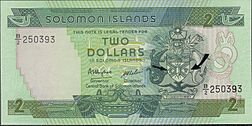Solomon Islands dollar facts for kids
Quick facts for kids Solomon Islands dollar |
|||
|---|---|---|---|
|
|||
| ISO 4217 Code | SBD | ||
| User(s) | |||
| Inflation | 9.0% | ||
| Source | Central Bank of Solomon Islands, January 2023. | ||
| Subunit | |||
| 1⁄100 | cent | ||
| Symbol | $, SI$ | ||
| Coins | 10, 20, 50 cents, $1, $2 | ||
| Banknotes | $5, $10, $20, $50, $100 | ||
| Rarely used | $2, $40 | ||
The Solomon Islands dollar (its code is SBD) is the money used in the Solomon Islands. It has been the official currency since 1977. You might see its symbol as $, but often people use SI$ to show it's the Solomon Islands dollar and not another country's dollar. Each dollar is made up of 100 smaller units called cents.
Contents
History of the Solomon Islands Dollar
Before the Solomon Islands dollar came along, people in the Solomon Islands used different kinds of money.
Early Money
For a long time, the Australian pound was used in the Solomon Islands. Sometimes, the Solomon Islands even printed its own banknotes, which were known as the Solomon Islands pound.
During the Second World War, when Imperial Japan took control of the Solomon Islands, they introduced a special currency called the Oceanian pound. This "Japanese Invasion Currency" was used until the war ended, and then the Australian pound was used again.
From Pound to Dollar
In 1966, the Australian dollar took the place of the pound. This Australian dollar was used in the Solomon Islands until 1976, just before the country became independent.
The Solomon Islands dollar was officially launched in 1977. It replaced the Australian dollar, and for a while, one Solomon Islands dollar was worth exactly one Australian dollar. This lasted until 1979. After that, the value changed, and the Solomon Islands dollar became worth less compared to the Australian dollar. Over the years, especially during a difficult time from 2000 to 2003, the value of the Solomon Islands dollar went down quite a bit.
Coin Shortage
Around 2008, the coins became so low in value that many islanders started keeping them as souvenirs or giving them to children. This led to a shortage of coins! In some areas, people even started using traditional items like dolphin teeth as a form of money. The government had to ask people to bring their extra coins to the bank to help fix the problem.
Coins of the Solomon Islands
Coins are an important part of the Solomon Islands dollar.
First Coin Series
In 1977, the first coins were made. They came in values of 1, 2, 5, 10, and 20 cents, and also a 1 dollar coin. The cent coins were similar in size and material to the Australian coins. The 1 dollar coin was a unique seven-sided coin. Each coin had a special image on its back, showing something important to the local culture. For example, the 10 cent coin showed Ngoreru, a sea god.
Over time, the materials used to make the coins changed. For instance, in 1985, steel covered in bronze was used for the 1 and 2 cent coins. In 1988, a 50 cent coin was introduced. It had twelve sides and was first made to celebrate ten years of independence. Later 50 cent coins simply showed the country's national crest.
Because prices went up, the 1 and 2 cent coins became less useful. Now, prices are usually rounded to the nearest 5 cents.
Second Coin Series
In 2012, new, smaller coins were made. These included 10, 20, and 50 cent coins, and new 1 and 2 dollar coins. The old coins had become too expensive to make. The new 2 dollar coin replaced the 2 dollar banknote. The 1, 2, and 5 cent coins were stopped because they were not worth much anymore.
The new 1 and 2 dollar coins look a lot like the Australian 1 and 2 dollar coins. They are similar in size, color, and thickness. However, they are made of slightly different metals and have different weights.
All the coins in the Solomon Islands currently show a picture of Elizabeth II, who was the Queen of Solomon Islands.
Banknotes of the Solomon Islands
Banknotes are the paper money used in the Solomon Islands.
On October 24, 1977, the first banknotes were released. These were in values of 2, 5, and 10 dollars. A 20 dollar note was added in 1980. The very first banknotes had a picture of Queen Elizabeth II. However, all the banknotes made after that showed the national crest instead.
Later, 50 dollar notes were introduced in 1986, and 100 dollar notes came out in 2006. In 2001, a 2 dollar banknote made of plastic (polymer) was tried, but it went back to being made of cotton in 2006.
The 2006 series of banknotes had new safety features to prevent fake money. These included brighter colors, a special shiny foil on the 50 and 100 dollar notes, and a security thread woven into the paper. In 2013, a new 50 dollar note was released with even more advanced security features. This was the first of a new set of banknotes that would be introduced over five years as older notes wore out.
All the banknotes show pictures of daily life and things that are important to the culture of the islands. Each note has a different theme.
The Central Bank of Solomon Islands is in charge of printing all the banknotes.
See Also
- Solomon Islands
- Economy of Solomon Islands
- Australian dollar
- New Zealand dollar
- Fijian dollar



